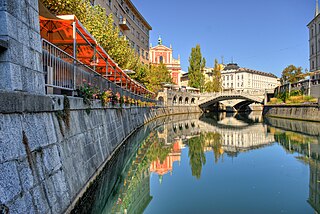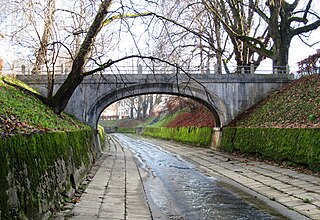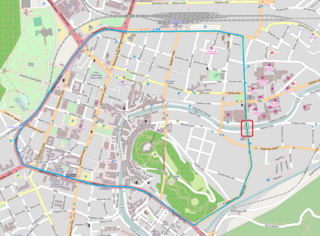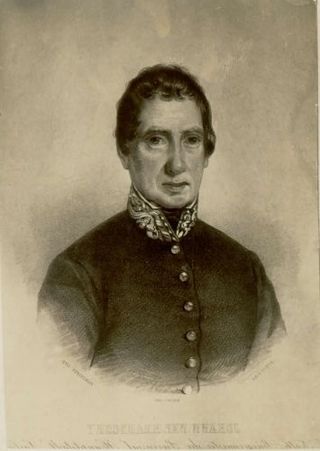
Ljubljana is the capital and largest city of Slovenia, located along a trade route between the northern Adriatic Sea and the Danube region, north of the country's largest marsh, inhabited since prehistoric times. It is the country's cultural, educational, economic, political and administrative center and the seat of Urban Municipality of Ljubljana.

Jože Plečnik was a Slovenian architect who had a major impact on the modern architecture of Vienna, Prague and of Ljubljana, the capital of Slovenia, most notably by designing the iconic Triple Bridge and the Slovenian National and University Library building, as well as the embankments along the Ljubljanica River, the Ljubljana Central Market buildings, the Ljubljana cemetery, parks, plazas. His architectural imprint on Ljubljana has been compared to the impact Antoni Gaudí had on Barcelona.

The Ljubljanica, known in the Middle Ages as the Leybach, is a river in the southern part of the Ljubljana Basin in Slovenia. The capital of Slovenia, Ljubljana, lies on the river. The Ljubljanica rises south of the town of Vrhnika and flows into the Sava River about 10 kilometres (6.2 mi) downstream from Ljubljana. Its largest affluent is the Mali Graben Canal. Including its source affluent the Little Ljubljanica, the river is 41 km (25 mi) in length. The Little Ljubljanica joins the Big Ljubljanica after 1,300 m (4,300 ft) and the river continues its course as the Ljubljanica.

The Triple Bridge comprises three bridges spanning the Ljubljanica River in Ljubljana, the capital of Slovenia. It connects the historical medieval town on the southeastern bank with the central Prešeren Square on the northwestern bank. Dating back to the 13th century, it stands as the oldest bridge in Ljubljana. In the early 1930s, the architect Jože Plečnik redesigned and expanded it. In August 2021, the Triple Bridge was added to the UNESCO World Heritage List as part of Plečnik's enduring legacy.

Prešeren Square is the central square in Ljubljana, the capital of Slovenia. It is part of the old town's pedestrian zone and a major meeting point where festivals, concerts, sports, political events, and protests take place. It was redesigned according to plans by Edvard Ravnikar from a funnel-shaped to a circular form in 1987–88 and renovated in 2007.

The Kresija Building or Kresija Palace is a building that along the Philip Mansion marks the entrance to the old town of Ljubljana, the capital of Slovenia. It stands at the Adamič and Lunder Embankment on the right bank of the Ljubljanica immediately downstream of the Triple Bridge, bordering Pogačar Square, Stritar Street, and Maček Street. Until 2007, the building housed the Ljubljana Center Administrative Unit. Now, there are municipal offices, the Kresija Gallery, and the Ljubljana visitor centre.

The Dragon Bridge is a road bridge located in Ljubljana, the capital of Slovenia. It crosses the Ljubljanica River. between Kopitar Street and Ressel Street, to the north of the Ljubljana Central Market at Vodnik Square. It was built in the beginning of the 20th century, when Ljubljana was part of the Austro-Hungarian Empire. As one of the best examples of reinforced concrete bridges and of the Vienna Secession style, the bridge is today protected as a technical monument. It is intended primarily for motorised traffic.

Philip Mansion is a building in central Ljubljana, the capital of Slovenia. It is located along the river Ljubljanica, at the corner of the Cankar Embankment and Stritar Street, next to the Triple Bridge. On the other side of Stritar Street stands the Kresija Building. The two buildings mark the entry into the town's medieval part under Ljubljana Castle.

The Cobblers' Bridge or the Shoemakers' Bridge is a pedestrian bridge crossing the river Ljubljanica in Ljubljana, the capital of Slovenia. It connects two major areas of medieval Ljubljana. It is decorated by two kinds of pillars, the Corinthian pillars which delineate the shape of the bridge itself and the Ionic pillars as lamp-bearers. Built upon the plans by the architect Jože Plečnik, it was inscribed in August 2021 as part of Plečnik's legacy on the UNESCO World Heritage List.

The Butchers' Bridge is a footbridge crossing the river Ljubljanica in Ljubljana, the capital of Slovenia. It connects the Ljubljana Central Market and the Petkovšek Embankment. The bridge was solemnly opened on 10 July 2010.

The Rooster Bridge in Ljubljana, the capital of Slovenia, is a footbridge crossing the Gradaščica River in the Trnovo District south of the downtown of Ljubljana. It stands between the Trnovo Bridge and the outflow of the Gradaščica into the Ljubljanica, and connects Gradaščica Street in the northern Krakovo neighbourhood to Eipper Street in the southern Trnovo neighbourhood. These are the oldest Ljubljana suburbs, known for their market gardens and cultural events.

St. Peter's Bridge, also Ambrož Bridge, is a bridge in Ljubljana, the capital of Slovenia, that crosses the river Ljubljanica in the northeastern end of the old town. It is a continuation of Rozman Street. West of it lie Vraz Square on the northern (left) bank of the river and Ambrož Square on its southern (right) bank. East of it lies the Petkovšek Embankment on the northern bank and the Poljane Embankment on the southern bank. The bridge is named after the nearby St. Peter's Church. It is intended primarily for motorised traffic, but is also used by pedestrians.

The Ljubljanica Sluice Gate, or the Partition, is a sluice gate and a triumphal arch on the Ljubljanica River in Ljubljana, the capital of Slovenia. It is located between Cukrarna and Vraz Square in the Center District, east of the Ljubljana old town, a bit downstream of Ambrož Square. It was designed in 1939 by the Slovene architect Jože Plečnik, who envisaged it as a monumental farewell to the Ljubljanica River on its exit from the Ljubljana city centre. It was planned to be used as a footbridge as well. The sluice gate was built with difficulty from 1940 until 1943 by the constructor Matko Curk. Since July 2009, it has been protected as a monument of national significance, along with other major works by Plečnik. Since August 2021, the Ljubljanica Sluice Gate has been inscribed as part of Plečnik's legacy on the UNESCO World Heritage List.

The Grain Bridge is a footbridge over the Ljubljanica River in Ljubljana, the capital of Slovenia. It is located between Tanner Street and Gestrin Street, and links the Petkovšek Embankment on the left side of the river and the Poljane Embankment on its right side. It is used by local residents and students of the Poljane Grammar School and has relieved of pedestrians the St. Peter's Bridge and the Dragon Bridge.
The Ljubljana Central Market is a market in Ljubljana, Slovenia. The riverside market building, sometimes referred to as Plečnik's Market, was designed by Jože Plečnik between 1931 and 1939. It stretches between the Triple Bridge and the Dragon Bridge, on the right bank of the Ljubljanica River. The marketplace and Vodnik Square, where it is located, are cultural monuments of national significance. It is partly located at Adamič and Lunder Embankment and at Pogačar Square.

Dvor is a village on the right bank of the Krka River in the Municipality of Žužemberk in southeastern Slovenia. The area is part of the historical region of Lower Carniola. The municipality is now included in the Southeast Slovenia Statistical Region.

The Fabiani Bridge is a two-level bridge over the Ljubljanica River in Ljubljana, the capital of Slovenia. It links Njegoš Street with Rog Street and thus completes the Ljubljana's inner ring road. The bridge has been named after its original conceptor Max Fabiani (1865–1962) and was opened to the public on 22 August 2012. The architect in charge of the design was Jurij Kobe.

Johann Nepomuk Felix Hradeczky was an Austrian politician.
Viktor Markelj is a Slovenian structural engineer and bridge specialist.




















